
Tom Scott Vineyard Newsletter - March 2016 - Barn Burner Cabernet Sauvignon

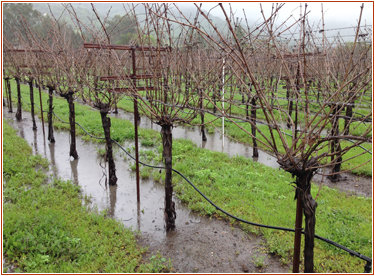 We are singing in the rain, what a glorious feeling, we're happy again! That seems to be the refrain every living thing here in the Napa Valley is singing! After four severe drought years, we are pruning in the rain. The most frequent question we get is whether all this rain will be enough and did it arrive in time? The short answer is that we don't know yet. We are singing in the rain, what a glorious feeling, we're happy again! That seems to be the refrain every living thing here in the Napa Valley is singing! After four severe drought years, we are pruning in the rain. The most frequent question we get is whether all this rain will be enough and did it arrive in time? The short answer is that we don't know yet.
One of the things that make Napa Valley a world-famous growing region is the pattern of our rain. Rain usually begins in early autumn and continues into early spring. We then have a warm growing season from April through harvest in October. The previous years' drought left us with a dry autumn, winter, and spring. While autumn is a time when the vines aren't producing new growth, it's still an important time since this is when the vines replenish their reserves following the previous growing season.
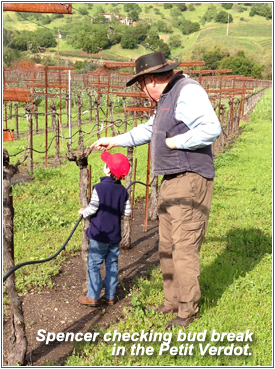 All substances that enter the roots from the soil must be dissolved in water. Under favorable conditions, the tissues of the vine roots accumulate high concentrations of starch, amino acids and citric acid in autumn. These materials serve as food and food material for the next year. When the soil is lacking the necessary water to dissolve substances, the future of the plant is threatened. All substances that enter the roots from the soil must be dissolved in water. Under favorable conditions, the tissues of the vine roots accumulate high concentrations of starch, amino acids and citric acid in autumn. These materials serve as food and food material for the next year. When the soil is lacking the necessary water to dissolve substances, the future of the plant is threatened.
These reserves are stored as carbohydrates that remain in the vine at an almost constant level during the winter, which is the vines' dormant season. The carbohydrates change back and forth from starch to sugar and then back again to starch. The amount of carbohydrate accumulation is closely associated with how the buds develop. All buds have the internal structure to develop into either a leaf bud or a fruit bud; it is the carbohydrates that influence what the bud will become. The accumulation of starch is most rapid in the mid-section of the shoot, from the fourth to the eighth node; this accumulation triggers the development of fruit buds. This is, therefore, where most of our crop will develop. When we lay a ten-bud cane down on the fruiting wire of our trellising, we have assured that the most fruitful positions - the fourth to the eighth nodes - are supported and positioned for optimum development.
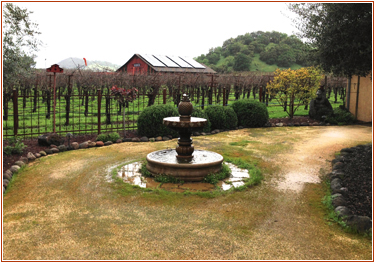 In 2015 our vines budded and set in a way we had never seen before. The autumn drought reduced carbohydrates to the flowers before bloom. Poor nutrition to the flowers led to loose or straggly clusters, and small seedless berries commonly called shot berries. Shot berries fail to develop and remain small, round and hard. In 2015 our vines budded and set in a way we had never seen before. The autumn drought reduced carbohydrates to the flowers before bloom. Poor nutrition to the flowers led to loose or straggly clusters, and small seedless berries commonly called shot berries. Shot berries fail to develop and remain small, round and hard.
In terms of heat during the growing season, we were above normal in the spring, above normal in the summer and above normal as well at the end of the season. The development of the fruit was 2-3 weeks early in most of the valley, with our harvest two weeks ahead of our old "normal."
We did get rain this past autumn, so hopefully the plants had time to build up their carbohydrates. The rain we've received more recently has helped replenish our ground water, bringing our fields back up to full field capacity. Overall, our fields have absorbed about 20 inches of rain in the last 5 months.
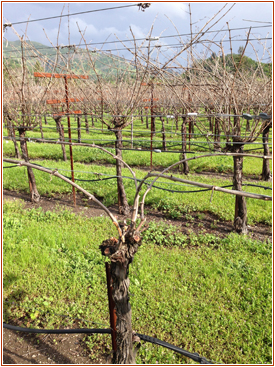 We are seeing damage in some vines we're currently pruning. We agreed before we began that we would not ask any more of a vine than we had last year, and in fact we might step it back. By increasing or decreasing the number of buds we leave, we can increase or decrease production. We knew when we started we would not add more buds or canes, and we have already decreased a number of vines. We hope to be finished pruning by the first week in April, and then we'll have to wait and see how the vineyard comes along. We will be standing by ready to respond to developments as they unfold. We are seeing damage in some vines we're currently pruning. We agreed before we began that we would not ask any more of a vine than we had last year, and in fact we might step it back. By increasing or decreasing the number of buds we leave, we can increase or decrease production. We knew when we started we would not add more buds or canes, and we have already decreased a number of vines. We hope to be finished pruning by the first week in April, and then we'll have to wait and see how the vineyard comes along. We will be standing by ready to respond to developments as they unfold.
We want to thank everyone that has come to visit us, everyone that has walked the vineyard with us and who has bought our wine. We know when you come to the Napa Valley you have a choice of where to go. There are always new wineries and new wines. Thank you for continuing to make Barn Burner and us a part of your story.
By the way... we opened and enjoyed a bottle of 2004 Barn Burner on Lauren's birthday! Wow! All we can say is don't forget what you have in the cellar!
Cheers!
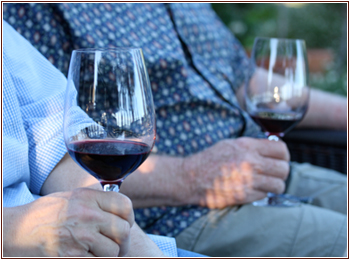
Tom and Lauren Scott
www.tomscottvineyard.com
www.tomscottvineyard.com/wineshop
info@tomscottvineyard.com
Back-issues of our Notes

|



